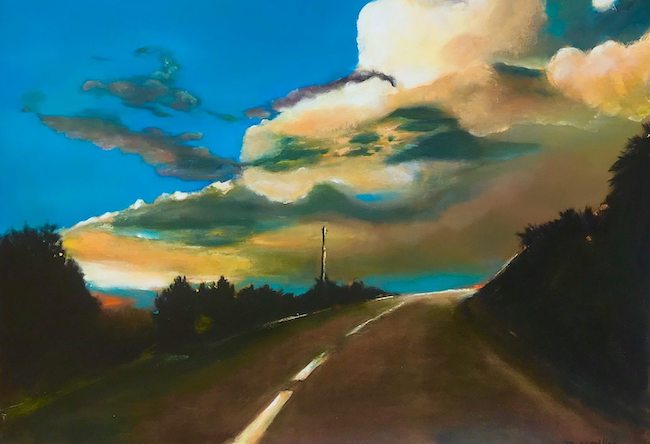Osservare la natura che circonda l’essere umano è stato uno dei cardini dell’arte più recente, soprattutto l’interrogarsi sulla correlazione tra l’individuo e l’ambiente in cui agisce, in cui struttura la propria esistenza, ha costituito una linea preponderante per tutto quel filone artistico, e di pensiero, che indagava sull’influenza che le energie circostanti generano sull’uomo, sull’invito alla contemplazione che alcune situazioni e alcuni panorami riescono a stimolare. Molti creativi hanno bisogno di rimanere fortemente legati alla realtà perché attraverso di essa effettuano un percorso di consapevolezza e di presa di coscienza dell’attualità in cui vivono, mentre altri hanno la necessità di partire dal visibile per essere poi in grado di trascenderlo, attraverso il loro approccio meditativo e di ascolto delle sensazioni, e di collocare all’interno di quelle realtà significati più umanistici e filosofici. La protagonista di oggi mette in luce il desiderio di immaginare, e poi di scoprire, tutto ciò che si trova dietro l’oggettività, quella sussurrata incognita evocata, nel suo caso, con un tendere verso l’oltre.
Il fascino della rappresentazione del paesaggio ha cominciato a divenire un genere pittorico di alto livello solo verso gli inizi dell’Ottocento, quando il Romanticismo Inglese con i suoi grandi maestri come William Turner e John Constable, e quello Americano con Thomas Cole e Frederich Edwin Church della Hudson River School, cominciarono a permeare le loro opere di poesia, ad arricchire l’osservato con le sensazioni sublimi e serene evocate dai panorami di fronte ai loro occhi, spesso privi della presenza umana. Da quel momento in avanti il Paesaggismo conobbe fortune alterne, a volte messo a tacere dall’attenzione verso l’essere umano emersa e sostenuta dal Realismo, altre invece ritrovato e reinterpretato nell’Impressionismo, nel Divisionismo e nello stile inconfondibile dei Macchiaioli, stili pittorici che però ricercavano piuttosto la perfetta resa del visibile mettendo in secondo piano l’emozione, la sensazione che riceveva l’autore dell’opera, sebbene in alcuni autori come Claude Monet la lirica che dall’estetica si distaccava faceva e fa vibrare le corde interiori. La rottura con la figurazione e l’impossibilità di rappresentare una realtà spaventosa come quella vista durante il periodo dei conflitti mondiali e concretizzatasi con tutti i movimenti di Arte Informale, generò successivamente un desiderio di ritorno all’ordine, un’esigenza di recuperare quella serenità visiva troppo a lungo tenuta lontana che diede vita in Italia al paesaggismo silenzioso e rilassante degli artisti aderenti al milanese Gruppo Novecento, capitano da Mario Sironi e Giorgio Morandi, e da quelli della romana Scuola di Via Cavour. Ma furono di fatto gli Stati Uniti a non abbandonare mai il legame con il paesaggio pur adattandolo al nuovo Esistenzialismo che stava trasformando la società e l’interiorità umana inducendo così gli autori appartenenti al Realismo Americano, tra cui Robert Henri ed Edward Hopper, a porre l’attenzione sull’influenza dello stato d’animo, della riflessione che l’individuo avvia quando si trova solo con se stesso e immerso nella realtà che lo circonda, sia essa naturale o urbana. Le opere di questi autori lasciano fuoriuscire tutto quel silenzio, tutta quell’introspezione che necessita l’uomo per andare oltre ciò che viene visto con gli occhi fino poi a spingersi ad ascoltarsi profondamente, ponendosi in relazione con l’ambiente in cui vive e in cui sogna, che lo accoglie e al tempo stesso ne evidenzia solitudine e malinconia.
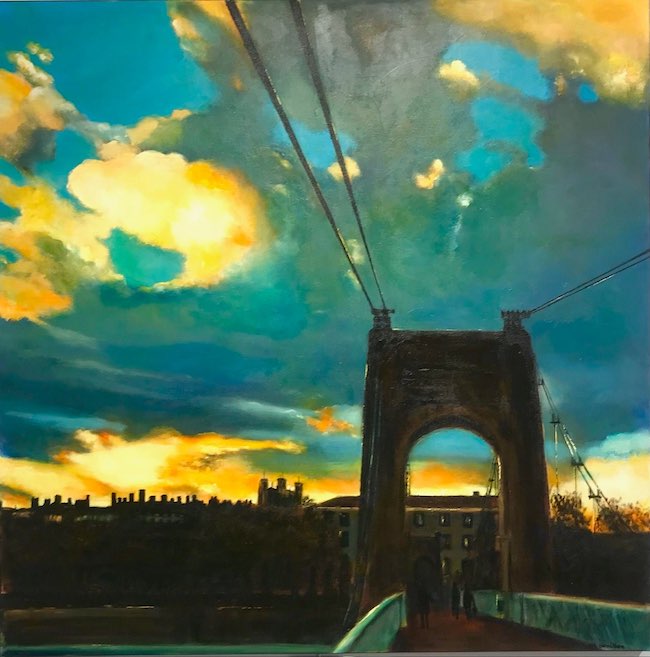
L’artista francese Mireille Cornillon si rifà al Realismo Americano escludendo però la presenza umana, come se dei paesaggi che contraddistinguono la sua produzione artistica l’autrice volesse narrare solo il sentire, l’emozione, l’immaginazione che alcuni luoghi possono evocare; in un certo modo l’assenza sottolinea il ruolo di spettatore dell’uomo che forse ha proprio bisogno di farsi da parte, di rimanere dietro il punto di osservazione per essere in grado di lasciar fluire quella capacità intuitiva e spirituale troppo spesso lasciata in silenzio. La capacità contemplativa della Cornillon avvolge letteralmente il fruitore dell’opera che non può fare a meno di perdersi, di lasciar vagare la sua fantasia dentro quelle strade che potrebbero appartenere a un luogo e a nessuno, e che sembrano condurre verso l’infinito, l’eterno a cui l’essere umano anela senza aver alcuna possibilità di raggiungerlo.
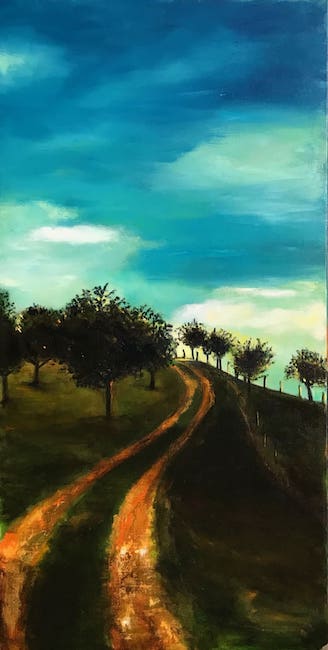
La gamma cromatica da un lato attinge alle tonalità reali dall’altro vira in maniera quasi espressionista verso un’esaltazione dell’alternanza tra luce e ombra, dove la prima domina così tanto da enfatizzare la seconda che appare in tutta la sua oscurità quasi a tendere verso quei varchi di luminosità che a volte appartengono al cielo fuoriuscendo dalle nubi, altre invece sbucano dalla fine di una curva, da un punto lontano dall’osservatore che diviene l’obiettivo finale dell’immaginazione, del sogno, di tutto il non visibile che in Mireille Cornillon è prospettiva fiduciosa di ciò che potrà essere.
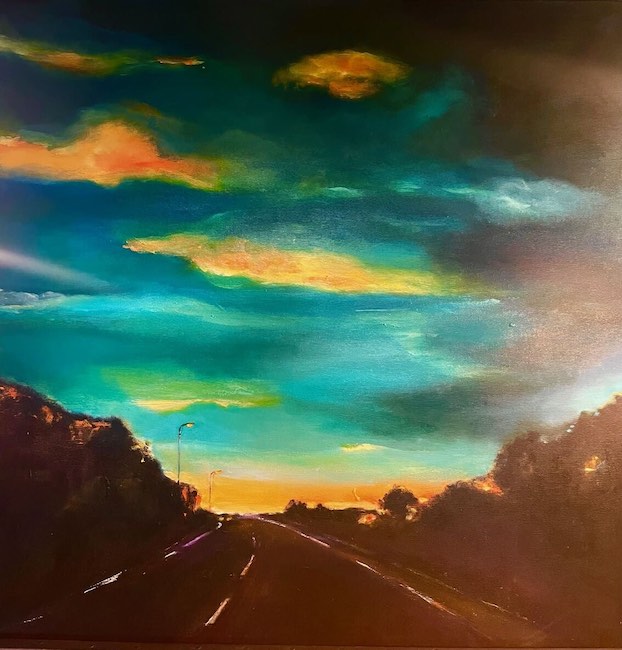
Questo è il fulcro poetico delle sue opere, il sottile suggerimento di una positività oltre la contingenza, di una prospettiva che apre le porte a un oltre differente dal percorso originario e che induce a desiderare di correre verso quell’oltre; le strade, spesso elemento essenziale delle tele della Cornillon, evocano la metafora del cammino che deve essere percorso per compiere quell’evoluzione, quell’avanzamento che condurrà verso dei nuovi sé, più consapevoli, più forti proprio in virtù di tutto ciò che è stato affrontato prima.
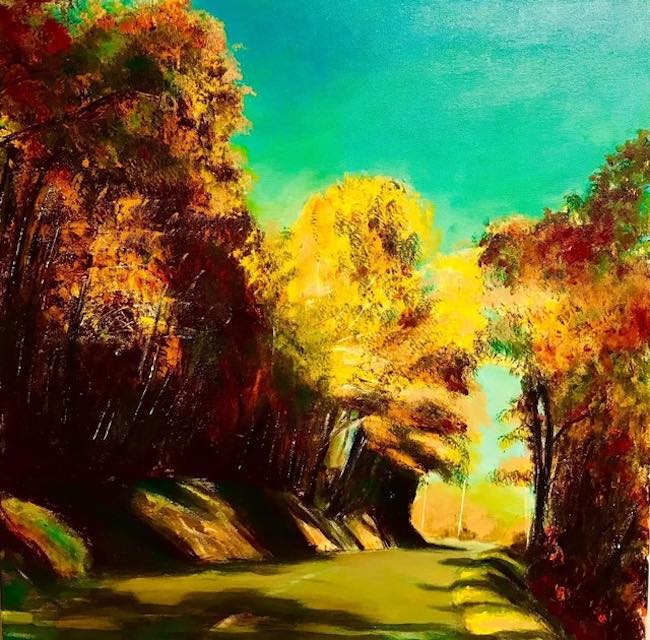
L’orizzonte si trasforma pertanto non in una fine, piuttosto in un nuovo inizio, in una promessa di nuove opportunità e di realizzazione di quei desideri spesso considerati chimere che l’essere umano custodisce gelosamente dentro di sé e che qualche volta ha persino timore di confessare a se stesso ma che nelle opere dell’artista divengono istanti di luce, chiaramente indicati da una strada che si può scegliere di percorrere oppure di fermarsi a contemplarla, decretando così la direzione del proprio futuro.
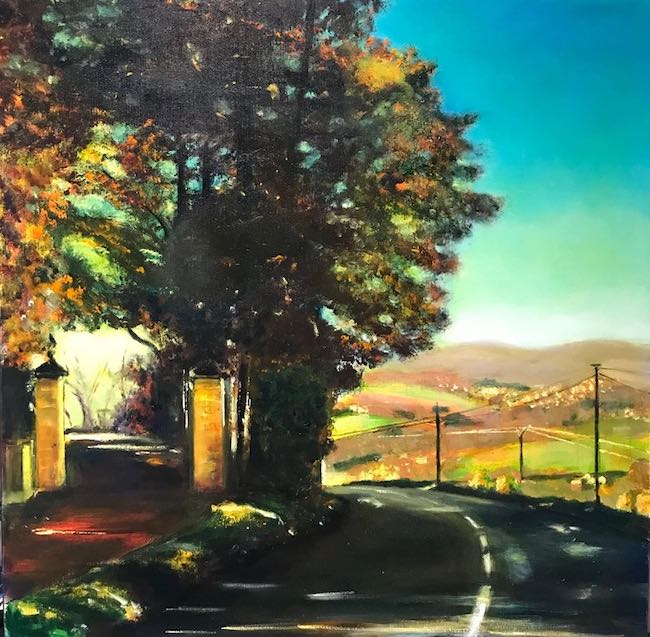
Nella tela Au bout de l’allée (Alla fine della via) questo concetto è fortemente presente, il bivio delle possibilità che conducono verso opzioni differenti, una apparentemente più rassicurante perché diretta verso il viale di ingresso di una casa, l’altra invece più incerta poiché tendente verso un altro luogo, invisibile in prospettiva; l’osservatore è dunque chiamato a immedesimarsi in chi sta percorrendo quel cammino e a compiere una scelta che svela l’attitudine personale a mettersi in discussione e rischiare di fare un salto nell’incognito, avendo la pazienza di raggiungere un punto certamente più distante ma da cui potrebbero nascere prospettive migliori suggerite dalla luminosa vallata sottostante, oppure in quello di chi preferisce restare nel tepore della certezza, indicato da una luce intensa che si intravede subito dopo l’ombra degli alberi del vialetto di ingresso al casolare, ottenibile nell’immediato rinunciando però a tutto ciò che potrebbe derivare da una scelta diversa. In entrambi i casi la luce è ciò che viene dopo, sottolineando l’atteggiamento positivo di Mireille Cornillon secondo cui il meglio deve ancora arrivare.
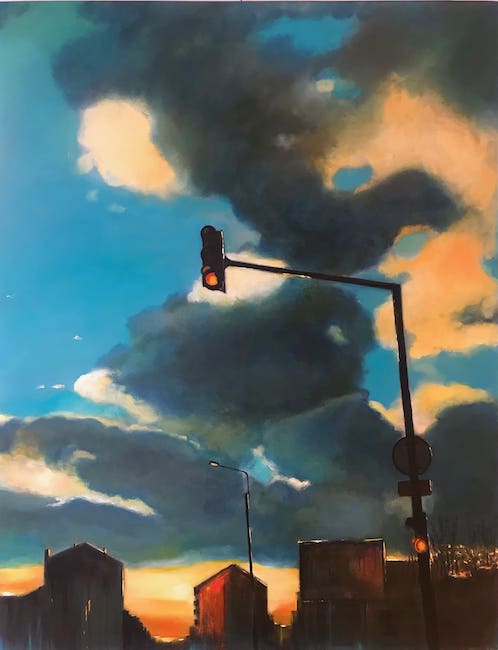
La sua capacità di osservazione vicina al Realismo Americano la induce a mettere in evidenza quei dettagli apparentemente insignificanti che però appartengono alla quotidianità, alla vita dell’uomo contemporaneo, al suo colpo d’occhio di tutti i giorni divenuto talmente familiare da essere a malapena notato mentre nello sguardo dell’artista assume un fascino lirico irresistibile; questa capacità si traduce in opere come Feux tricolores, dove un semplice semaforo arancione riesce a infondere un senso suggestivo a tutto ciò che si trova al di sotto di sé, i tetti delle case e i loro comignoli, lasciando immaginare tutta la vita che si trova più giù in strada, mentre lui svetta nella sua silenziosa immobilità quasi ad assicurarsi che tutto sia in ordine. In qualche modo questa opera suggerisce la staticità dell’esistenza, quel ripetersi quotidiano di abitudini, di percorsi sempre uguali a se stessi a cui spesso si affida l’ordine delle cose senza prendere in considerazione la possibilità di rompere gli schemi e prendere decisioni che vanno a destabilizzarlo quell’ordine. Mireille Cornillon mette così in luce il dualismo dell’uomo moderno, quella spinta inconfessata a raggiungere l’infinito, le molteplici opportunità che appartengono alla relatività della realtà, contrastata tuttavia dalla certezza di rimanere all’interno di una zona sicura che non presenta incognite né il rischio di spiacevoli evoluzioni ma neanche di sorprendenti ed emozionanti risvolti.

Mireille Cornillon, pur avendo inizialmente seguito studi in campo farmaceutico, dopo aver vissuto un anno a San Francisco durante il quale si è mantenuta con i suoi ritratti a pastello, decide di non abbandonare più la sua arte, diplomandosi presso l’Accademia d’Arte di Lione, la città in cui vive e lavora, e dal 2005 si dedica esclusivamente alla carriera artistica realizzando molte mostre personali nella sua città e partecipando a importanti esposizioni collettive in tutto il mondo – Giappone, Cina, Stati Uniti, Svizzera -.
MIREILLE CORNILLON-CONTATTI
Email: mireillecornillon@gmail.com
Sito web: www.mireille-cornillon.com
Facebook: https://www.facebook.com/mireille.cornillonartiste
Instagram: https://www.instagram.com/mireillecornillon/
The gaze towards infinity in Mireille Cornillon’s Landscape Realism, where roads go everywhere and in no place
Observing the nature that surrounds the human being has been one of the cornerstones of recent art, especially the questioning of the correlation between the individual and the environment in which he acts, in which he structures his existence, has constituted a preponderant line for all that artistic strand, and of thought, that investigated the influence that the surrounding energies generate on man, on the invitation to contemplation that certain situations and certain panoramas manage to stimulate. Many creatives need to remain strongly attached to reality because through it they carry out a path of awareness and consciousness of the actuality in which they live, while others need to start from the visible in order to then be able to transcend it, through their meditative approach and listening to sensations, and to place more humanistic and philosophical meanings within those realities. Today’s protagonist highlights the desire to imagine, and then to discover, all that lies behind objectivity, that whispered unknown evoked, in her case, with a tendency towards the beyond.
The fascination with the depiction of the landscape only began to become a high-level pictorial genre towards the beginning of the 19th century, when English Romanticism with its great masters such as William Turner and John Constable, and American one with Thomas Cole and Frederich Edwin Church of the Hudson River School, began to permeate their artworks with poetry, to enrich the observed with the sublime and serene sensations evoked by the panoramas before their eyes, often devoid of human presence. From then on, Landscape painting experienced alternating fortunes, at times silenced by the attention to the human being that emerged and was sustained by Realism, at others rediscovered and reinterpreted in Impressionism, in Divisionism and in the unmistakable style of the Macchiaioli, pictorial styles who, however, sought rather the perfect rendering of the visible, putting the emotion, the sensation received by the author of the work, in the background, although in some authors such as Claude Monet the lyricism that detached itself from aesthetics made and still makes inner chords vibrate.
The break with figuration and the impossibility of representing a frightening reality such as the one seen during the period of the world wars and realised with all the movements of Informal Art, subsequently generated a desire for a return to order, a need to recover that visual serenity that had been kept away for too long, which gave rise in Italy to the silent and relaxing landscape painting of the artists belonging to the Milanese Novecento Group, led by Mario Sironi and Giorgio Morandi, and those of the Roman Scuola di Via Cavour. But it was in fact the United States that never abandoned the link with the landscape, although adapting it to the new Existentialism that was transforming society and human interiority, thus leading the authors belonging to American Realism, including Robert Henri and Edward Hopper, to focus on the influence of the state of mind, of the reflection that the individual initiates when he is alone with himself and immersed in the reality that surrounds him, be it natural or urban. The artworks of these authors let out all that silence, all that introspection that man needs in order to go beyond what is seen with his eyes, to then push himself to listen deeply, placing himself in relation with the environment in which he lives and in which he dreams, which welcomes him and at the same time highlights his solitude and melancholy. The French artist Mireille Cornillon refers to American Realism, but excludes the human presence, as if the author only wanted to narrate the feeling, the emotion, the imagination that some places can evoke; in a certain way, absence emphasises the role of spectator of the man who perhaps really needs to step aside, to remain behind the point of observation in order to be able to let flow that intuitive and spiritual capacity that is too often left in silence. Cornillon‘s contemplative capacity literally envelops the viewer of the artwork who cannot help but get lost, to let his imagination wander inside those roads that could belong to a place and to no one, and that seem to lead towards infinity, the eternal for which the human being yearns without having any chance of reaching it.
The chromatic range on the one hand draws on real tones, on the other it veers in an almost expressionist manner towards an exaltation of the alternation between light and shadow, where the former dominates so much as to emphasise the latter, which appears in all its darkness almost tending towards those gaps of luminosity that sometimes belong to the sky emerging from the clouds, others, instead, goes out from the end of a curve, from a point far away from the observer who becomes the final objective of the imagination, of the dream, of all the non-visible that in Mireille Cornillon is a confident perspective of what could be. This is the poetic fulcrum of her paintings, the subtle suggestion of a positivity beyond contingency, of a perspective that opens the door to a beyond that is different from the original path and that induces the desire to run towards that beyond; the roads, often an essential element of Cornillon‘s paintings, evoke the metaphor of the path that must be travelled in order to make that evolution, that advancement that will lead towards new selves, more aware, stronger precisely because of all that has been faced before. The horizon is thus transformed not into an end, but rather into a new beginning, into a promise of new opportunities and the fulfilment of those desires often considered chimeras that human beings jealously guard within themselves and that at times they are even afraid to confess to themselves, but that in the artist’s works become instants of light, clearly indicated by a road that one can choose to follow or to stop and contemplate, thus decreeing the direction of one’s future.
In the canvas Au bout de l’allée (At the End of the Road), this concept is strongly present, the fork in the road leading to different options, one apparently more reassuring because it is directed towards the driveway of a house, the other more uncertain because it tends towards another place, invisible in perspective; the observer is therefore called upon to identify with those who are walking along that path and to make a choice that reveals a personal aptitude for questioning themselves and risking a leap into the unknown, having the patience to reach a point that is certainly more distant but from which better perspectives suggested by the luminous valley below might arise, or in that of those who prefer to remain in the warmth of certainty, indicated by an intense light that can be glimpsed immediately after the shade of the trees in the driveway at the entrance to the farmhouse, which can be obtained immediately, however, by renouncing everything that might result from a different choice. In both cases, light is what comes next, underlining Mireille Cornillon‘s positive attitude that the best is yet to come. Her observational skills close to American Realism lead her to highlight those seemingly insignificant details that nevertheless belong to everyday life, to the life of contemporary man, to his everyday glance that has become so familiar that it is barely noticed, while in the artist’s gaze it takes on an irresistible lyrical charm; this ability translates into artworks such as Feux tricolores (Traffic ligths), where a simple orange traffic light manages to imbue everything below it, the roofs of houses and their chimneys, leaving one to imagine all of life further down the street, while he towers in his silent stillness almost as if to ensure that everything is in order. Somehow this painting suggests the static nature of existence, that daily repetition of habits, of paths that are always the same, to which we often entrust the order of things without considering the possibility of breaking the mould and making decisions that destabilise that order. Mireille Cornillon thus highlights the dualism of modern man, that unconfessed urge to reach the infinite, the multiple opportunities that belong to the relativity of reality, contrasted, however, by the certainty of remaining within a safe zone that does not present unknowns nor the risk of unpleasant evolutions, but also of surprising and exciting developments. Although Mireille Cornillon initially pursued studies in the pharmaceutical field, after living in San Francisco for a year during which she supported herself with her pastel portraits, she decided not to abandon her art any longer, graduating from the Academy of Art in Lyon, the city where she lives and works. Since 2005, she has devoted herself exclusively to her artistic career, holding many solo exhibitions in her city and participating in important group exhibitions all over the world – Japan, China, the United States, Switzerland.


